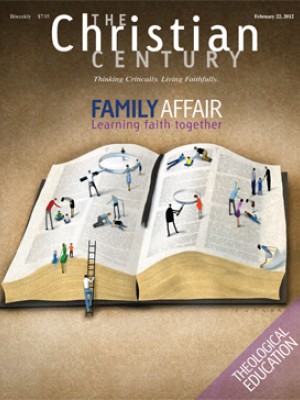Oprah, by Kathryn Lofton
Until I read Oprah: The Gospel of an Icon, I would not have said that I was a connoisseur of the world of O. My contact with Oprah has been limited to watching a few episodes of her show in the early 2000s and occasionally glancing through her magazine while at a friend's house. But the eerie feeling I had while reading Kathryn Lofton's account of the TV maven is that I have been breathing Oprah's reality, vocabulary, consumer choices and worldview in the cultural air all around me. I have not been immune to the Gospel of Oprah, and the fact that her influence on me has been unrecognized makes it no less profound.
I admit that I am dismayed by this new knowledge. Oprah, in Lofton's terms, represents the state of contemporary spirituality: the spirit of consumer goods. All roads, no matter how spiritual, lead back to buying more stuff. Oprah is both pitchwoman and preacher of this worldview—two roles that are indistinguishable. Oprah helps her audience find the choices that will help them to live their "best life"—spiritually, economically, physically and emotionally. She does this by selling her own taste as a commodity. This is a carefully crafted and cultivated taste—one that will always sell to the widest possible audience. Oprah, in Lofton's account, is a unifying, syncretistic force that draws together various cultural dimensions and then gives them her personal stamp. She encourages her viewers to do the same, collecting whatever products, ideas or beliefs will suit their ideal existence. Oprah makes her own choices into a spectacle so others can sift more easily through the unrelenting parade of contemporary ideas and products.
Read our latest issue or browse back issues.
In 2003, Lofton reports, Oprah reopened her long-standing book club. Her choice for the relaunching was John Steinbeck's East of Eden. The episode in which this choice is announced includes a giddy tour of Chicago in a bookmobile, during which Oprah drops off gift-wrapped copies of the book to surprised viewers and delivers sales pitches for the swimsuits that viewers might wear while reading. ("Gotta look cute when you're reading," Oprah says before going to a commercial break.) Oprah ends the episode by urging her viewers to "go right out and get yourself a copy" of the new book, then adds as if spontaneously, "You know I love that little Chrysler truck"—referring to the vehicle she had used as a bookmobile. "Ever since Celine Dion had her baby in the Chrysler. . . . Let me get a Chrysler truck. Thank you so much. Thanks, everybody."
Lofton points out how the edifying and the commercial realities are conflated, with no distinction made between the surface (how Oprah's viewers look while reading) and the depth (what they might learn from reading). Lofton knows that religion and the marketplace are longtime companions in America, and she is not imagining or searching for a market-free space for religion. At the same time, she has an "itching uncertainty" about Oprah's unrelenting claim that the modern person, especially the modern woman, is going to feel better when she buys the right goods.
Personal transformation is central to the Gospel of Oprah, and Lofton finds precedence for Oprah's brand of evangelism in the 19th-century reformer Charles Finney. In Finney's "anxious bench," a standard part of his revivals, Lofton sees the closest precursor to Oprah's talk-show couch. Finney lined up well-to-do citizens who confessed their deepest longings and most egregious sins and finally expressed their commitment to God and their intention to reform. The "anxious bench" was, Lofton explains, "a formal prop in the script of conversion." People who attended Finney's revivals knew what to expect from these converts, and the element of spectacle was a driving force in the revivals' popularity.
Oprah has obviously dropped some of the Christian dimensions of this practice. The conversion she seeks from her guests isn't an explicitly Christian one, though the form is definitely Protestant in its construction. She believes in the power of confession to work miracles in people's lives. Her couch serves as a vehicle for the confession that will fulfill both her own and her audience's expectations. Like Finney, Oprah centralizes belief as a transformative force.
A key difference, of course, is that Oprah is primarily preoccupied with beliefs about the self. For example, "If you are not moving forward," she tells her audience, "it is a shadow belief, because we become what we believe." The purging of "shadow beliefs" creates the "aha moments" that are a central part of Oprah's lexicon.
As important as transformation is (Oprah dubbed her television presence "Change Your Life TV"), it is frequently reduced to the concept of the makeover. The need for a makeover is universal, and Oprah offers new beginnings to everyone at all times through the proper use of commodities and practices. All personal problems, from a messy closet to an unhappy marriage, can be resolved by the miracle of the right advice by the right experts, consumption of the right products, and what Lofton calls the right psychological and emotional expulsion on Oprah's show. And yet the end result is often as facile as obtaining a new pair of shoes, a new shade of lipstick or a new haircut. Makeovers are merciless in their perpetuation. There is no end to our need for them, and no part of our lives is immune to their touch.
While Oprah frequently highlights the struggles of American women, she doesn't so much solve their problems as accessorize them. Lofton gives the example of Oprah's "Princess for a Day" theme. In 2003, Oprah celebrated the struggles of a woman named Fannie Eugene. In the montage that preceded the crowning of "Princess Fannie" with a tiara, we learn that Eugene works two jobs as a nanny for two wealthy white families in order to support seven recently orphaned children and her ailing husband. She drives hours to work every day and is her family's sole provider. In her "Princess for a Day" package, Eugene receives weekly Merry Maid service, a Ford Windstar minivan and a "deluxe trip for two to New York City, accessorized by new luggage." Wouldn't you feel good after receiving such luxurious gifts for no other reason than just being you?
Oprah's audience and Eugene are expected to respond with joy to this spontaneous and generous giving. Yet Eugene's story has unacknowledged layers that Change Your Life TV cannot transform. Even after receiving a minivan, Eugene still has to drive a long way to work. The gifts do nothing to relieve Eugene's fundamentally stressful situation. With or without Oprah, she still has to face her challenges with dwindling resources. Was it written into the contract that she couldn't sell the $24,000 minivan in order to feed, clothe and shelter her family?
In 2009, after Hurricane Katrina, Oprah revisited Eugene's story. Her crew found the former "princess" living in a FEMA trailer after her home was destroyed in Hurricane Katrina. Eugene tells the story of wearing her tiara as she piled her family and neighbors into the minivan and fled the impending storm. Eugene's story is meant to be moving. It encourages our sympathy.
But Oprah is unwilling to consider or explore structural realities at work in Eugene's life. Personal transformation ultimately offers nothing to alter the basic struggles of her existence. Harpo (Oprah's corporate entity) "cannot remake the politics of disaster, nor will it enter into an examination of Delta economics." It will only accessorize the struggle with better transportation and better luggage. Only selves can be transformed, Oprah implicitly argues, not societies.
Lofton's book is rich in these kinds of explorations. Her analysis of Oprah and Oprah's corporate presence is pointed and frequently sarcastic. But the book does not take us quite as far into the unfolding drama of Oprah's iconic status as we might expect. For example, although Lofton offers a provocative epilogue about the relationship between Oprah and President Obama, her discussion of Oprah's Leadership Academy for Girls in South Africa does not mention the scandals that rocked the school in 2007 and again in 2009. Nor does Lofton consider Oprah's post-talk show career.
Still, this book offers a great deal to consider about contemporary culture and religion. If Lofton is right that Oprah is representative of the state of our current spirituality, I am definitely going to need something to make myself feel better. Maybe I need to go shopping.






